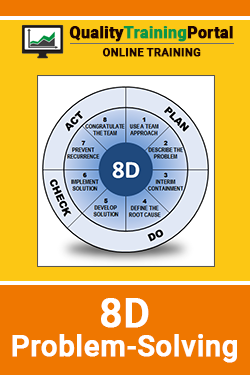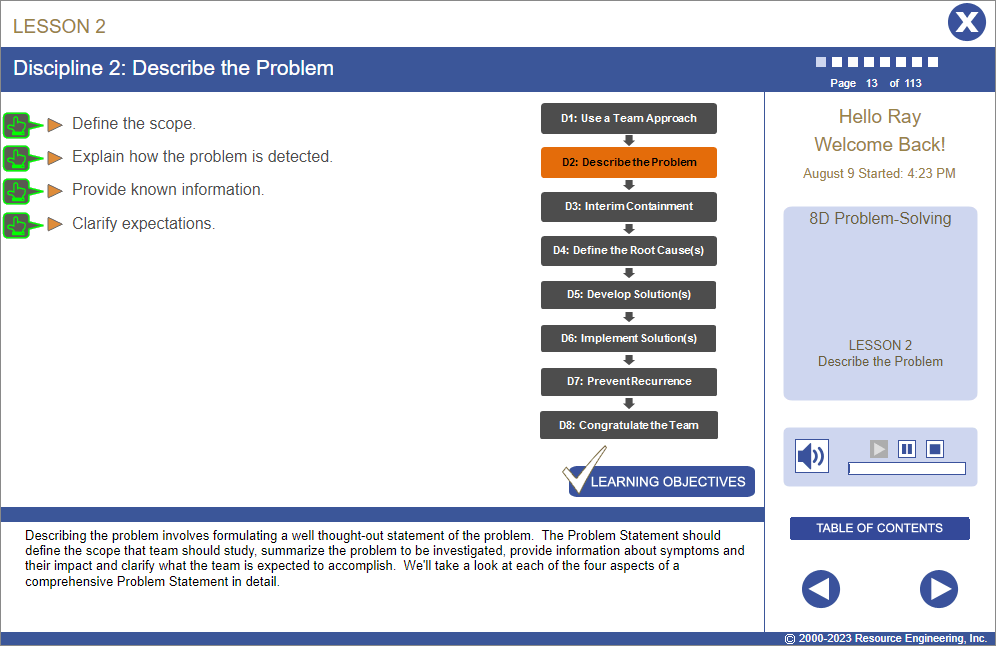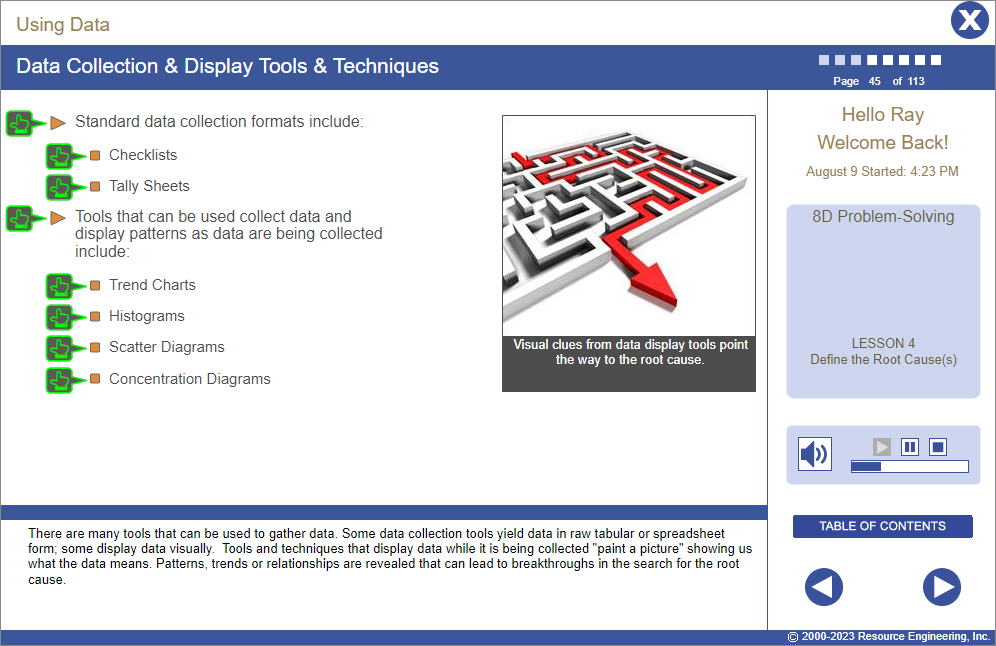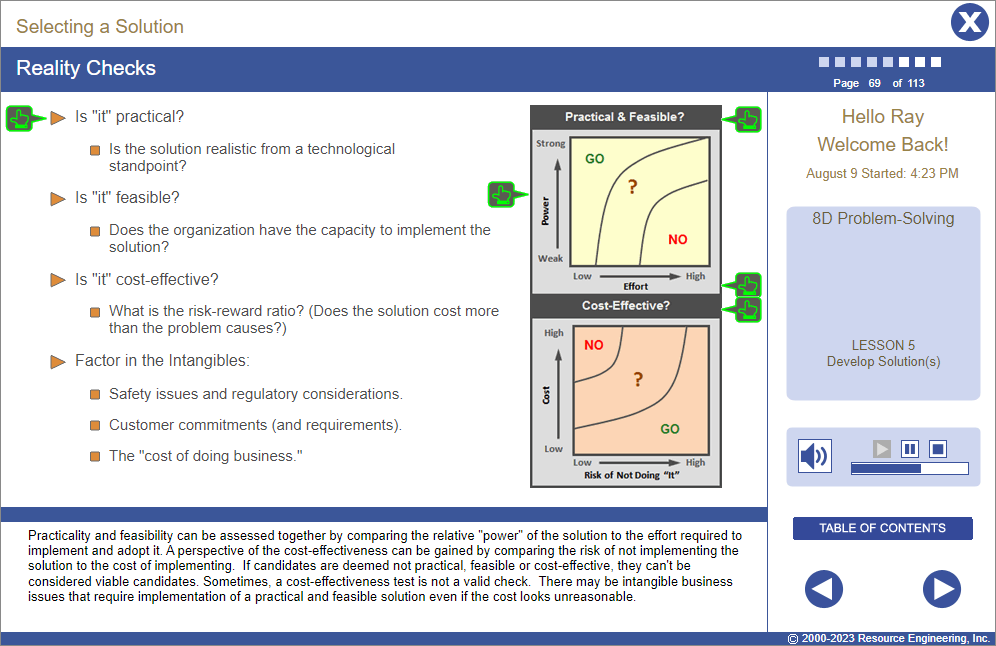Course Information
8D Problem Solving Training
Learners will be able to:
- Make lasting improvements using the 8D Problem-Solving Process.
- Collect and analyze data that helps get to the root cause of problems.
- Generate solutions that prevent future issues.

About This Course
Our 8D Problem Solving Training offers a comprehensive online program designed to equip participants with the necessary skills and knowledge to effectively address and resolve complex problems. This formal training is structured around the renowned 8D problem-solving methodology, providing a systematic approach for identifying, analyzing, and implementing solutions.
Through this training, participants will gain a deep understanding of the eight disciplined steps involved in the problem-solving process. They will learn how to define the problem, form a cross-functional team, conduct root cause analysis, develop and implement corrective actions, and establish preventive measures to mitigate future issues.
Delivered in an engaging and interactive format, our 8D Problem Solving Training combines theoretical concepts, practical examples, and case studies to enhance the learning experience. Participants will also have access to supplemental resources, including templates and tools, to facilitate the application of the 8D methodology in their real-world problem-solving scenarios.
By completing our 8D Problem Solving Training, individuals will be equipped with the skills and confidence to lead effective problem-solving initiatives within their organizations, driving continuous improvement and fostering a culture of excellence.
- Learners should have a specific team problem-solving project in mind to work on before taking this course.
- English (EN-US)
- Chinese (simplified) (ZH)
- Czech (CS)
- French (FR)
- German (DE)
- Italian (IT)
- Japanese (no audio) (JA)
- Korean (no audio) (KO)
- Polish (PL)
- Portuguese (Brazilian) (PT-BR)
- Romanian RO)
- Russian (RU)
- Spanish (ES)
- Vietnamese (no audio) (VI)
Course Objectives
- Learn how to use the 8-Discipline process to work through and solve a problem in a team.
- Use problem-solving tools and techniques to collect and analyze data, make decisions and evaluate the effectiveness of an implemented solution.
- Document team progress and solutions using forms and worksheets.
Course Outline
Lesson 1 | Discipline D1
- Use a Team Approach
- Form an effective project team.
- Define roles of the team members.
- Set boundaries of freedom for the team.
- Help get the team started up.
Lesson 2 | Discipline D2
- Describe the Problem
- Understand the scope and magnitude of the problem.
- Develop a Problem Statement.
- Recognize that the task is to investigate the problem, not jump to solutions.
Lesson 3 | Discipline D3
- Interim Containment
- Determine if Interim Containment is needed.
- Design and put temporary measures into place to “buy time” until a permanent solution can be developed and implemented.
- Verify that interim containment measures are working.
Lesson 4 | Discipline D4
- Define the Root Causes
- Use process mapping techniques to clarify the bounds of the process.
- Identify relationships between causes and the resulting effect using Cause and Effect Diagrams.
- Collect data and then use data display tools to visually analyze that data.
- Use Investigative Tools to uncover more clues to the root cause.
- Conduct confirmation runs to verify that the root cause has been found.
Lesson 5 | Discipline D5
- Develop Solutions
- Identify potential solutions that address the root cause.
- Consider solution candidates that will prevent the root cause from recurring as well as detection approaches that warn if the problem may recur.
- Remove candidates that are not practical, feasible or cost-effective from consideration.
- Use decision matrices to select the most balanced solution.
Lesson 6 | Discipline D6
- Implement the Solution
- Understand how to develop Action Plans using either Simple or Complex Action Plans formats.
- Learn how to use Project Management tools such as Activity Plans, PERT Charts and Gantt Charts to develop Action Plans to manage and track implementation of the solution.
- Recognize that the solution has been not fully implemented until related documentation is updated and communication has been completed with all involved parties.
Lesson 7 | Discipline D7
- Prevent Recurrence
- Use techniques to ensure the problem does not recur.
- Know which associated documents and systems to update.
- Remove Interim Containment measures.
- Recognize how powerful it can be to share LESSONs Learned.
Lesson 8 | Discipline D8
- Congratulate the Team
- Encourage the organization to recognize the problem-solving team for a job well done.
- Ensure the problem-solving team recognizes those that have assisted them.
Course Challenge
- An assessment of the learner’s progress in this course.

4.7 out of 5 stars
Comments from Learners About This Course
- A very informative guide to problem solving that will be valuable in my role
- Very interesting! This course has helped me to get more knowledge and tips about 8D Report. (Vietnamese speaker)
- Excellent course, even than I have been working as quality engineer for several years this course reminder me several of the techniques to use to address properly any opportunity detected in any process.
- Great Course. Although I have had 8D training I learned some new things and it helped me refresh some things.
- An useful training to refresh the mind of 8D problem solving method! Thank you.
- Great Course! the Reference Guide is very useful and the information was presented in a very clear, easy to follow manner.
- This course gave me a much wider understanding of my job description being a warranty engineer.
You may also be interested in…
- Mistake-Proofing Training – Comprehensive online training in poka yoke/mistake-proofing techniques for manufacturing operations.
- Error-Proofing Business Processes – This course explores how to error-proof transactional processes by studying both the server-side (service provider) and the customer-side of the transaction. Techniques to uncover the root cause of errors and then prevent their recurrence are covered.
- Cost of Quality – Learn how to effectively track and monitor COQ % over time to see if improvement efforts to reduce COQ are working.





